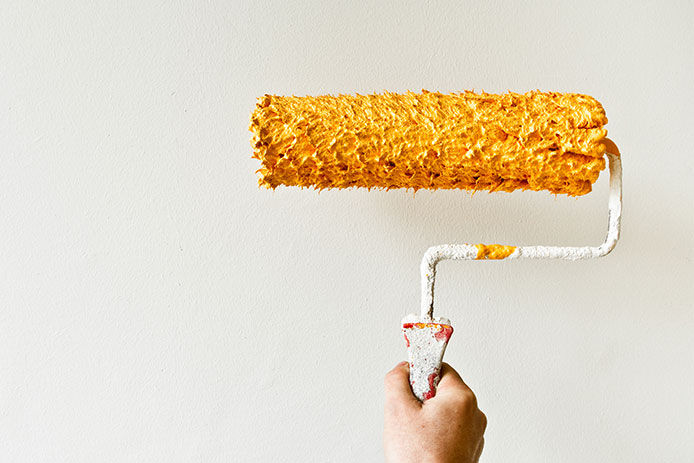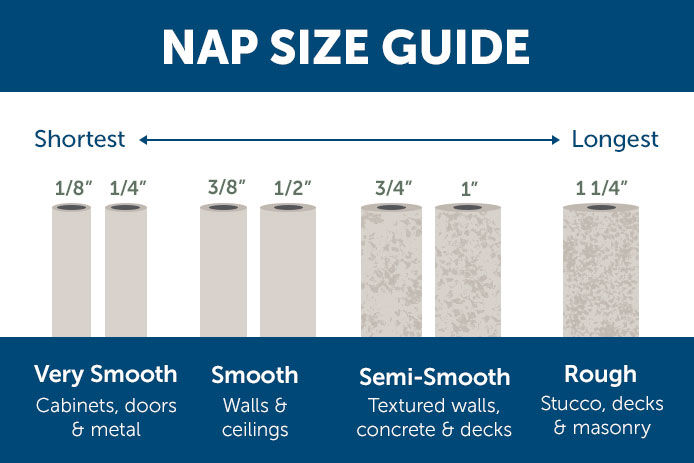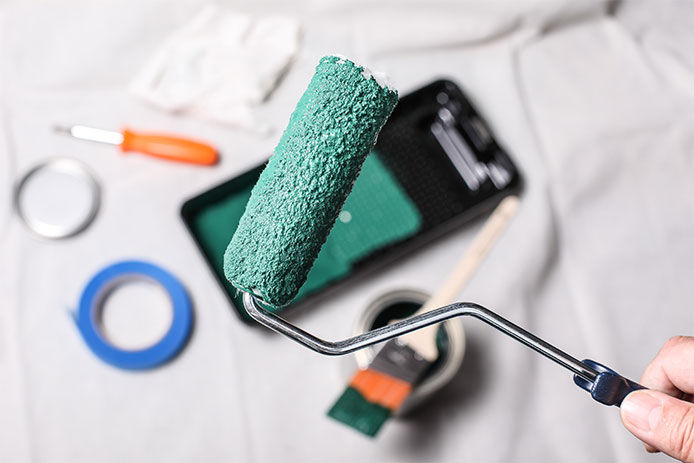How to Choose a Paint Roller

Paint rollers may all look similar, but even just a quarter-inch of thickness can make a big difference in the finished surface. The handle and base of the painting tool are known as the roller cage. Your roller needs to fit on the cage you choose, and it also needs to match the surface you’re painting and the type of paint you’re using.
Invest in a durable plastic or metal roller cage and a few different rollers to match to prepare yourself for all painting challenges.
Paint Roller Cover Material

First, consider the material you’re using to spread paint over the surface. Different types of roller fabric work better for different types of paint. Some options are:
Natural
Natural roller covers are often made with lamb’s wool or mohair and work really well with oil-based paints. They can be cumbersome to clean, but rinsing them quickly with paint thinner after each will help. We don't recommend using a natural roller cover with latex paints, as the water in it can easily cause matting and damage the fabric.
Synthetic
Polyester and nylon rollers, often labeled as synthetic fibers, are great for latex-based and acrylic-based products.
Blended
Blended roller covers are much more versatile and are made of a combination of natural fibers and polyester, offering both a smooth finish and durability. They work well with all types of paint.
Foam Rollers
Use a soft foam roller if you need to coat a porous surface or smooth surfaces that tend to bead up. These are great for projects like cabinets and anything that requires a smooth finish.
Specialty Rollers
Specialty products, like rag rollers, are used to create certain textures and finishes, so you’ll only need them for certain projects. Some examples include rollers covered in bunched-up rag bits, chunks of sea sponge, or patterns carved into foam. They’re usually used after a base coat of a neutral color is applied with a standard fiber-covered roller. Once the base paint dries, add a highlight coat with the specialty roller. Make sure to practice with the tool before applying it to the walls.
Picking the Right Thickness

The thickness or length of the nap on the roller determines what type of surface it works best on. The shortest naps you’ll find will measure only 1/8th to 1/4th inch. These rollers provide a mirror-like finish on very smooth surfaces. Foam rollers do the same on flat surfaces. If you’re painting over a lightly textured surface like lace-pattern drywall, try a 3/8ths- or 1/2-inch nap length.
Experts recommend using 3/4- to 1-inch rollers for highly textured surfaces like stucco, brick, or popcorn finish. If you’re working with a variety of primarily smooth surfaces and need a general-purpose roller, aim for around 1/2 inch.
Choosing a Roller Size

The wider the roller, the quicker the work of covering large wall areas will go. However, you’ll get messy results from trying to work near edges and corners with a big roller. 12- to 18-inch wide rollers offer speed and ease of coverage in open areas. Keep an 8-inch or 9-inch roller on hand to work around delicate areas and cut in without a brush. 3- to 4-inch wide rollers are great for doing trim, baseboards, and cabinets without any mess.
Nap Size
In addition to your roller width, you'll want to pay attention to the nap size too. This is the length of the fibers that make up the roller. Larger naps have longer fibers and are generally softer, while smaller ones are shorter and have more rightly grouped fibers. Use a larger nap size like a 3/4" - 1" for rougher surfaces like concrete and heavily textured walls and a smaller size like 1/4" - 3/8" for smooth surfaces like new walls, trim, and metal.
When to Use a Paint Roller

Paint rollers leave a thin and even coat of paint over a surface with little to no brush marks. While using a brush can take hours to coat a large wall, a roller with a telescoping handle can cover the same space in mere minutes. However, you do lose some control over the precise application of paint, especially when using a wide roller for quick coverage. Most people use a roller to coat the center of large walls or to quickly paint large furniture pieces and finish the edges and details with a brush. It’s an excellent alternative to a paint sprayer, where there’s no access for air compression or electricity since the roller can cover exterior and interior surfaces nearly as quickly with far less mess.
Paint rollers stay good for years if kept wrapped and stored out of sunlight. They work well for all types of home painting projects as long as you match them to the specific surface you’re coating. When you find a favorite brand or type, pick up a few extras for the next time you need to paint your home.